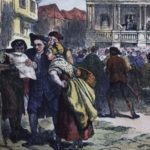Today, the American people vote for president and vice president on Election Day. But, technically speaking, these votes don’t directly determine the outcome of the election. These popular votes determine which electors will be appointed to the Electoral College, which is made up of 538 electors drawn from the states and the District of Columbia. Each state is granted a different number of electoral votes based on the size of its congressional delegation. The electors meet after the general election to cast their votes for president and vice president.
Popular Sovereignty and Constitutional Ratification

This short video highlights the importance of popular sovereignty in the ratification debates. The people themselves, through their elected delegates in specially-called conventions, voted up or down on the new Constitution. Professor John Kaminksi notes how the Antifederalists also used the principle of popular sovereignty to justify their call for constitutional amendments.
Should the Electoral College Be Reformed?
This deliberation has students view C-SPAN video clips to learn about the history and Constitutional background of the Electoral College. Students will also explore arguments for and against reforming the Electoral College. Using this information, students will develop and argue their position on the question: Should the Electoral College Be Reformed?